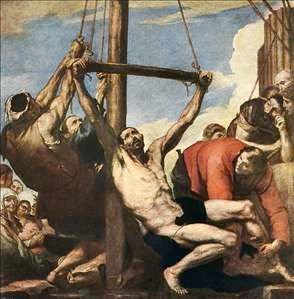 I remember horrifying a gay English leather-goods salesman in a pensione in Florence many years’ ago by admitting that if I saw a baby and a Raphael painting floating in the Arno, and I could only save one, I wasn’t sure which one I’d go for. “You can make more babies,” I said, “but a Raphael painting is irreplaceable.”
I remember horrifying a gay English leather-goods salesman in a pensione in Florence many years’ ago by admitting that if I saw a baby and a Raphael painting floating in the Arno, and I could only save one, I wasn’t sure which one I’d go for. “You can make more babies,” I said, “but a Raphael painting is irreplaceable.”Well, I was 19 at the time, my companions and I had had a few, I was pretty much drunk on the glories of Renaissance art, and I was stuck in that odd half-way house between religion and humanism, where everything is, let’s face it, relative. Besides, I’d just spent two weeks in Venice in August, after which it’s hard not to conclude that there might simply be too many people on this earth.
Jusepe de Ribera (1591-1652), a Spanish painter whose major works were produced in Italy, created three of my favourite pictures.
The first, The Boy with the Club-Foot (1642, Louvre) is simply the most magnificent celebration of the human spirit I know.
As Tom Lubbock tells us in an excellent piece in The Independent, there was a great vogue for paintings of beggar children at the time – leading one satirist to mock the buyers: “What they abhor in life, they love to see in pictures.”
But, plainly, Ribera’s picture has nothing to do with the sort of pretty, merry, idealised little barefooted scamps getting up to all sorts while leading amusing lives of sanitized poverty that, for instance, Murillo (albeit an extremely accomplished painter) was producing around the same time.
There’s nothing pretty, sanitized or idealized about Ribera’s boy. He’s a dirt-poor beggar (he’s holding a piece of paper giving him permission to beg: “Give Me Alms, for the Love of God”). He has a deformed foot. He is – probably - a dwarf. His teeth are dirty and he looks like he hasn’t had a bath in years: you can almost smell him.
The boy is, as they say, no oil painting.
And yet he has all the swagger of an aristocrat’s son. Everything about him speaks of pride: the jaunty angle of the picture-dissecting staff across his shoulder; the elegant turn of his club-foot; the bold, confident gaze; a grin that shows his delight at all this attention. He fills the frame, towers over the landscape: Ribera makes him more than our equal.
Life has thrown just about everything it can at this lad, and yet his spirit is utterly uncrushed and unbowed. His gaze is immensely cheering: it’s hard not to smile back. Despite that, the painting has the power to shame us: I never see it without asking myself, “What the hell have you got to complain about, you ungrateful fool!”
Of course, the satirist was right: if I met the modern equivalent of this boy in the street or on the tube, I’d run a mile. But if I were faced with the somewhat unlikely choice posed by that handbag-seller 40 years ago, I’d save the boy rather than his portrait.
Be a wrench, though!
The other two of Ribera’s masterpieces which never fail to strike a chord are his Archimedes (1630, Prado) – dirty fingernails, ragged cloak, crumpled papers: the “realest” scientist in all of art:
The Martyrdom of St Philip (1939, Prado) is about as shocking a depiction of the reality of self-sacrifice as one could imagine: this is a real man about to die a real death – just feel the weight of his body: you can hear his terrified whimpers, the grunts of effort from the men hoisting him off the ground, the uninterested murmurs of the spectators.
This is a terrified old man who doesn’t want to die.
What a superb painter!



No comments:
Post a Comment